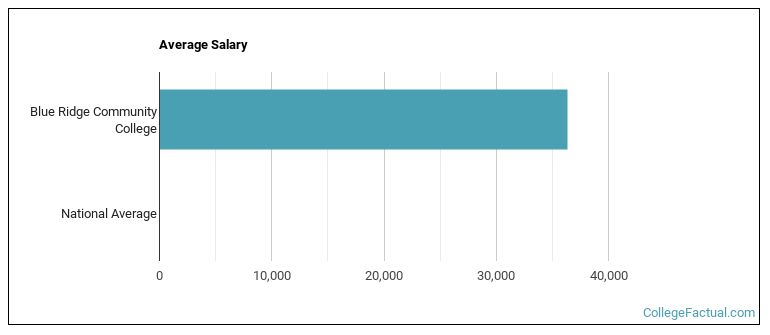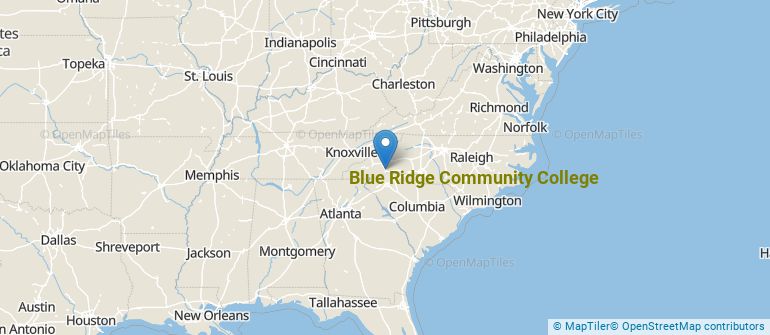 by our College Data Analytics Team
by our College Data Analytics TeamExplore the best ranked schools for the programs you are most interested in.
College Factual ranked Blue Ridge Community College as #1,986 out of 2,152 colleges and universities in the country on its 2025 Best Colleges list.
Blue Ridge Community College is also ranked #80 out of 93 schools in North Carolina.
Blue Ridge Community College has an open admissions policy, so you should not have much trouble being accepted by the school. Still, it is important to fill out the application completely and submit any requested materials, which may include proof that you have a high school diploma or the equivalent.
With a student to faculty ratio of 14 to 1, Blue Ridge Community College is about average in this regard as the nationwide rate is 15 to 1. While this does not translate directly to class size, it's a good indicator of how much time professors will have to spend with their students on a one-on-one basis.
When estimating how much access students will have to their teachers, some people like to look at what percentage of faculty members are full time. This is because part-time teachers may not have as much time to spend on campus as their full-time counterparts.
The full-time faculty percentage at Blue Ridge Community College is 24%. This is lower than the national average of 47%.
The freshmen retention rate tells us what percentage of first-year, full-time students choose to continue on to their sophomore year at a particular school. The rate at Blue Ridge Community College is 69%, which is about average when compared to the national rate of 68%.
During the 2017-2018 academic year, there were 2,399 undergraduates at Blue Ridge Community College with 665 being full-time and 1,734 being part-time.
| $0-30 K | $30K-48K | $48-75 | $75-110K | $110K + |
|---|---|---|---|---|
| $5,926 | $6,529 | $6,507 | $8,780 | $9,360 |
The net price is calculated by adding tuition, room, board and other costs and subtracting financial aid.Note that the net price is typically less than the published for a school. For more information on the sticker price of Blue Ridge Community College, see our tuition and fees and room and board pages.
While almost two-thirds of students nationwide take out loans to pay for college, the percentage may be quite different for the school you plan on attending. At Blue Ridge Community College, approximately 5% of students took out student loans averaging $7,024 a year. That adds up to $28,096 over four years for those students.
Get more details about paying for Blue Ridge Community College.

See which majors at Blue Ridge Community College make the most money.
Get more details about the location of Blue Ridge Community College.

Contact details for Blue Ridge Community College are given below.
| Contact Details | |
|---|---|
| Address: | 180 West Campus Drive, Flat Rock, NC 28731-4728 |
| Phone: | 828-694-1700 |
| Website: | www.blueridge.edu/ |
| Most Popular Majors | Bachelor’s Degrees | Average Salary of Graduates |
|---|---|---|
| Liberal Arts General Studies | 171 | NA |
| Business Administration & Management | 76 | NA |
| Precision Metal Working | 68 | NA |
| Accounting | 59 | NA |
| Vehicle Maintenance & Repair | 46 | NA |
| Cosmetology | 43 | NA |
| American Sign Language | 35 | NA |
| Nursing | 31 | NA |
| Teacher Education Grade Specific | 29 | NA |
| Computer Information Systems | 25 | NA |
Online courses area a great option for busy, working students as well as for those who have scheduling conflicts and want to study on their own time. As time goes by, expect to see more and more online learning options become available.
In 2022-2023, 2,763 students took at least one online class at Blue Ridge Community College. This is an increase from the 2,582 students who took online classes the previous year.
| Year | Took at Least One Online Class | Took All Classes Online |
|---|---|---|
| 2022-2023 | 2,763 | 1,119 |
| 2021-2022 | 2,582 | 1,111 |
| 2020-2021 | 738 | 556 |
| 2018-2019 | 216 | 143 |
Learn more about online learning at Blue Ridge Community College.
Footnotes
*The racial-ethnic minorities count is calculated by taking the total number of students and subtracting white students, international students, and students whose race/ethnicity was unknown. This number is then divided by the total number of students at the school to obtain the racial-ethnic minorities percentage.
References
More about our data sources and methodologies.